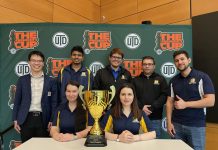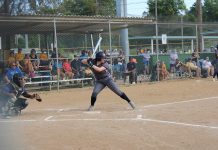For sophomore Nathan Freyling, the average day consists of a practice before sunrise, classes right after, and on some days, a second workout to follow.
Despite the taxing schedule, which he said took some getting used to, Freyling was named as one of 25 Webster University student-athletes to overcome the challenges, and be named to the Fall St. Louis Intercollegiate Conference (SLIAC) All-Academic Team. In Freyling’s case, he found success in using the same drive and motivation on the field, and translated it into academics as well.
“I am a very driven person, so if I say I’m going to do something then I will do it, whether that’s academically or athletically,” Freyling said. “So a lot of the time, I would tell myself I’m going to do this class this day and another class the next day, and that really makes me get my assignments done on time.”
Joining him are 24 other Gorlok student-athletes. Within the conference, Webster University tied for the second most student-athletes nominated with 25, trailing only Greenville University.
In order to qualify, athletes needed to maintain a 3.5 grade point average (GPA), be at least a sophomore, and have at least one year of schooling at the university.
Men’s soccer junior Miles Minnaar, understood in order to succeed toward this goal, he would have to sacrifice social gatherings and parties.
“There were a lot of nights where the stress was on, where I was pressed for time,” Minnaar said. “It’d be pretty easy to just skip practice. There were some late nights where you have to make some social sacrifices and you can’t hang with friends as much.”
Minnaar believed attempting to be productive before due dates were the blueprints to success. He said that procrastination was difficult to shake, but conversations with his parents were key in helping him to overcome the stress of the academic and athletic workload.
“When I get super stressed I like to procrastinate even more. I don’t know why, it’s horrible,” Minnaar said. “I will call my parents, I’ll ask how their day went and all that, I’ll complain, and then they will say, ‘Oh, well, you should probably go do your work.’ And they’re right.”
Athletes’ viewpoints on juggling the workload fluctuated from player to player. Women’s soccer player Melissa Kasper saw the challenge as something that prepared her for life.
“I love being busy, and I honestly find myself bored now that the season is over,” Kasper said. “I think being able to manage school and sports will only help me be prepared for the real world.”
Kasper was a part of a women’s soccer team that featured eight different athletes on the All-Academic Team. Both women’s soccer and women’s volleyball led the way with eight student-athletes.
Among the 25 student-athletes nominated, 12 of those were recurring members of the SLIAC All-Academic Team.
The All-Academic Team releases its nominees three times per calendar year for the fall, winter and spring seasons. During its next release, players on the baseball, golf, tennis and softball team will be eligible to join the team.
Webster University’s National Collegiate Athletic Association faculty advisor Scott Jensen said he saw the accomplish as indicative of the athletes’ ability to make an impact in more ways than one.
“I think when one school gets that many athletes recognized for not only being exceptional athletes, but exceptional students, it reinforces the commitment of our program,” Jensen said. “We build students that are well-rounded as students with a lot of potential in the classroom, which gives them more potential for after they graduate.”



